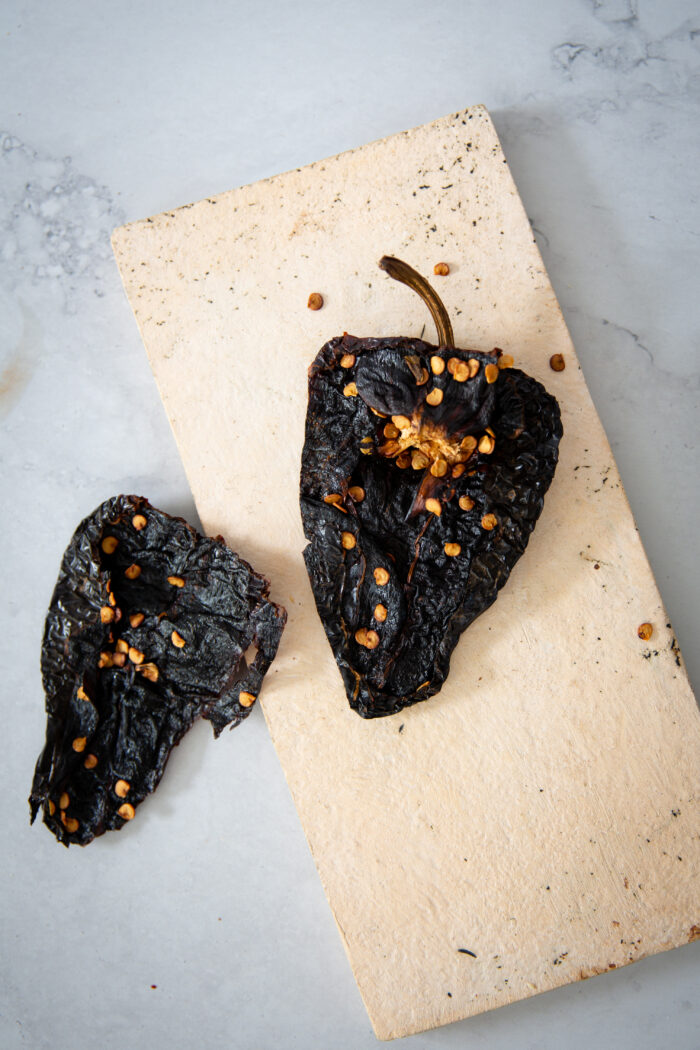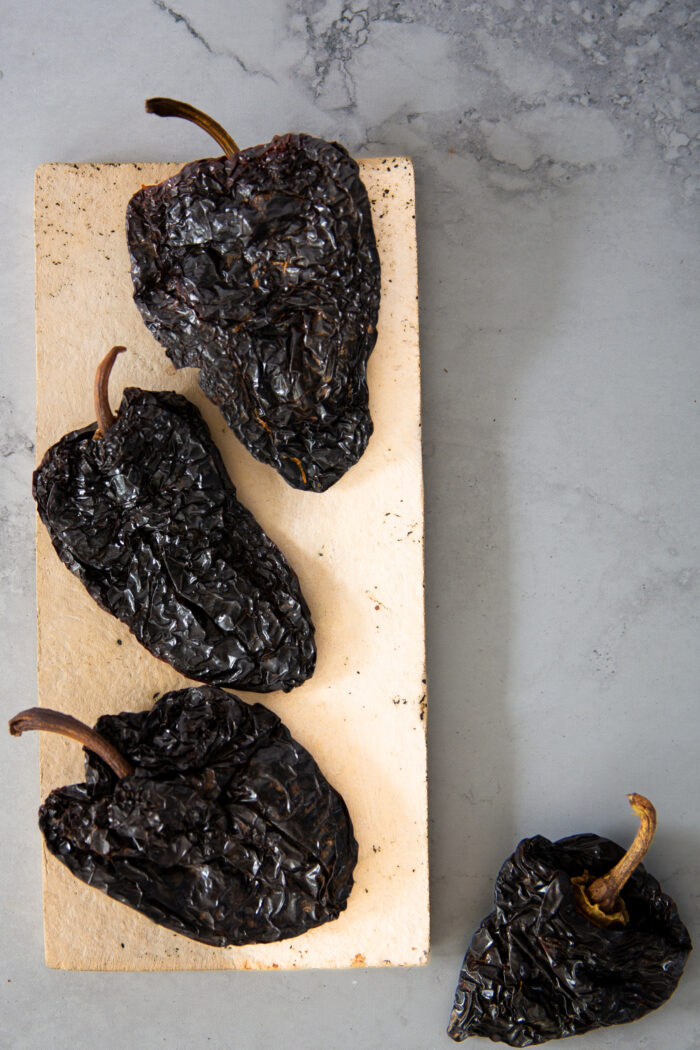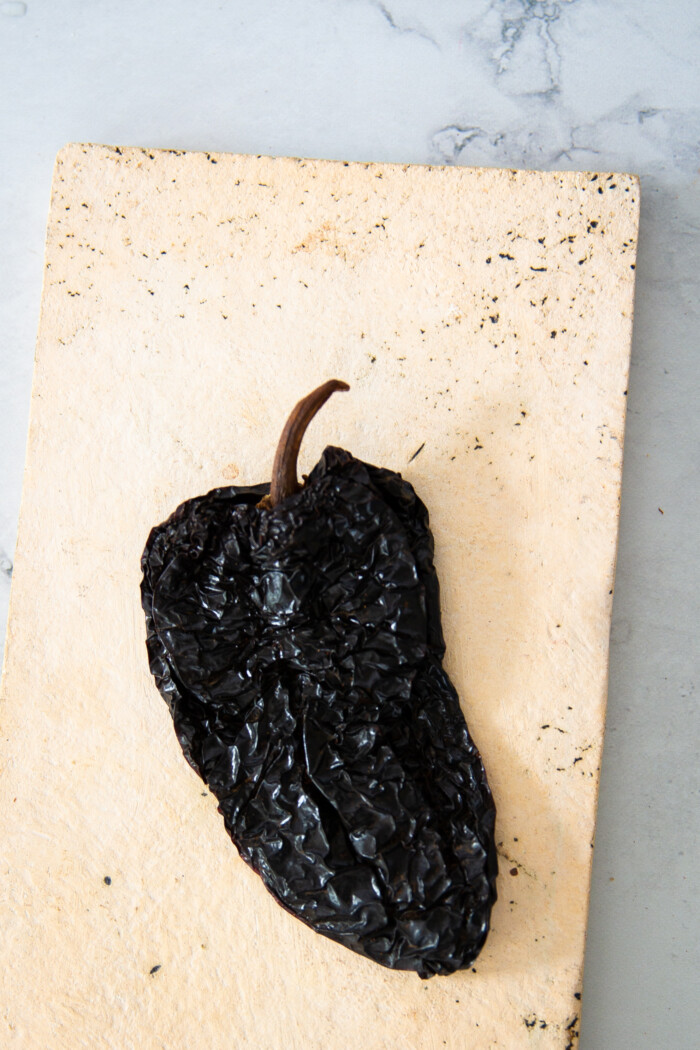Ancho chiles are widely used in Mexican cuisine. The specific flavor balance within an ancho chili is a really unique combination of smoky, spicy, and sweet.

What is an ancho chile?
An ancho chile starts out its life as a poblano pepper. That’s the name of the fresh pepper that’s grown in Puebla, Mexico, traditionally. After being harvested and ripened, the chile pepper is dried. Once dried, it becomes an ancho chili pepper.
Poblano chiles are harvested and cooked while they’re green. This leads to an interesting, slightly bitter flavor that adds an awful lot to dishes.
When the poblano peppers are allowed to ripen, they go from green to red and develop a lot of sweetness. This leads to an interesting and wonderfully tasty pepper in its own right. Then, that red pepper is dried to become an ancho chile. This is why an ancho chile is red, not green like a poblano.
Selecting and Storing Ancho Chile Peppers
When selecting dried chile peppers, the general advice is the same regardless of what specific chile you’re looking to find. Aim to pick up a chile pepper that’s soft, pliable, and a little shiny. On top of that, the pepper should not have any dust in the package, as that indicates insect damage.
We would certainly recommend ensuring that your ancho chile peppers are soft and pliable in the store. We’d recommend this as brittle peppers will have a stale flavor, not bringing as much as they could to your meals.
Always find chile peppers that are soft and pliable, while not being broken. A fresh chile will bend, not break. A broken chile, generally, is an old one.

Are ancho chile peppers hot?
No, ancho chile peppers aren’t that hot overall. The basic flavor of an ancho chile pepper is an interesting one – they’re quite sweet and chocolatey! The flavor itself is a little reminiscent of raisins, having a mild to medium-hot heat at the most basic level.
To be a little more specific – ancho chile has between one and two thousand Scoville heat units. This isn’t very hot at all and is generally less hot than a jalapeño pepper overall. When ground up and used as a seasoning, the heat level generally decreases, which leads to a well-balanced chile flavor.

How do you use them?
Ancho chile peppers are generally used to flavor sauces. They may be pureed before this happens, though this depends upon the recipes. Mole sauce is a well-known Mexican sauce – the primary flavoring of that sauce is ancho chiles!
Typically, ancho chiles are rehydrated before being pureed for food. The reason for this is that the flavor of the puree will be more consistent throughout than the chile itself.
A number of recipes suggest roasting ancho chiles before using them. This is suggested as the heat will draw some of the chile oils from the pepper, leading to a more complex flavor. Some notes that are lost in the drying process can be bought back to the forefront by roasting ancho chiles.

What is a good substitute for ancho peppers?
Ancho chiles are a really popular pepper – this means that they’re typically pretty easy to find, especially if you’re in a part of the world where Mexican food is regularly cooked and consumed. If you can’t find them where you are, though, they can be tricky to replace.
The specific flavor balance within an ancho chili is a really unique combination of smoky, spicy, and sweet. This means that your best option to replace them is often to find another ingredient that contains ancho peppers. For example, you can find dried, ground ancho chile peppers in most spice sections of supermarkets.
To use a different dried chile, though, your best options are mulato or guajillo peppers – while not identical, they have similarly complex flavors that will be tasty in your final dish.
Is chile ancho the same as chile guajillo?
No, these chiles are not the same. They come from different plants and are then ripened and dried in different ways.
Ancho chiles come from the poblano chile plant. The peppers are picked unripe, allowed to ripen to a deep red color, and are then dried to get that classic ancho flavor.
Guajillo chiles come from one of several varieties of the mirasol chile plant. These chiles are allowed to ripen on the plant, before being picked and dried.
While the two chiles are considered to have quite similar flavors and heat levels, they’re quite different, too. The fact that the two chiles are from different plants means that the final flavor is quite different. Different compounds within the chile fruit have been evolved to deter specific predators in the wild. Different plants will evolve different compounds in different locations, leading to different flavors.
What does ancho taste like?
Ancho chile peppers are defined by their developed taste and relative lack of heat. Their Scoville heat unit varies between 1000 and 2000, which puts them quite significantly below jalapeños, which are considered to be mild chiles.
During the ripening process, sweetness develops within the plant, leading to the final chile being balanced between sweetness and heat. During the drying process, a smoky flavor is instilled within the chiles, leading to an interesting combination. Their aroma is generally compared to that of a raisin – quite sweet and complex, while also being fruity and earthy.
Where to Buy Ancho Chile Pepper
You can typically buy ancho chile peppers in your supermarket – they’re a really popular variety of pepper! To find them in your supermarket, look near the Mexican food section. If they’re not there, then it’s likely you’ll be able to find them alongside the spices and herbs.
If you still can’t find dried peppers, you’ll likely be able to use ancho chile powder in your Mexican cooking – this has a similar flavor to the chiles themselves, though the grinding process reduces the heat level.
Ancho chile peppers are one of the most unique and celebrated ingredients in Mexican food. If you’ve never cooked with them before, we hope that learning a little about them here gives you the inspiration to try them out soon!
Recipes that you may like:
Other Mexican Chiles that you may like:
- healthy Homemade granola, vegan recipe - April 19, 2024
- How To Make Spring Minestrone (Easy, Healthy, Vegan) - April 18, 2024
- Homemade mangonada recipe - April 17, 2024
